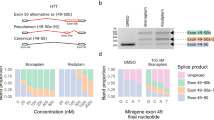Abstract
Familial idiopathic basal ganglia calcification (IBGC) is a genetic condition with a wide spectrum of neuropsychiatric symptoms, including parkinsonism and dementia. Here, we identified mutations in SLC20A2, encoding the type III sodium-dependent phosphate transporter 2 (PiT2), in IBGC-affected families of varied ancestry, and we observed significantly impaired phosphate transport activity for all assayed PiT2 mutants in Xenopus laevis oocytes. Our results implicate altered phosphate homeostasis in the etiology of IBGC.
This is a preview of subscription content, access via your institution
Access options
Subscribe to this journal
Receive 12 print issues and online access
$209.00 per year
only $17.42 per issue
Buy this article
- Purchase on Springer Link
- Instant access to full article PDF
Prices may be subject to local taxes which are calculated during checkout

Similar content being viewed by others
References
Manyam, B.V. Parkinsonism Relat. Disord. 11, 73–80 (2005).
Miklossy, J. et al. Acta Neuropathol. 109, 643–653 (2005).
Wider, C., Dickson, D.W., Schweitzer, K.J., Broderick, D.F. & Wszolek, Z.K. J. Neurol. 256, 839–842 (2009).
Oliveira, J.R. et al. Neurology 63, 2165–2167 (2004).
Dai, X. et al. Am. J. Med. Genet. B Neuropsychiatr. Genet. 153B, 1305–1310 (2010).
Bottger, P. & Pedersen, L. J. Biol. Chem. 277, 42741–42747 (2002).
Ravera, S., Virkki, L.V., Murer, H. & Forster, I.C. Am. J. Physiol. Cell Physiol. 293, C606–C620 (2007).
Prié, D. & Friedlander, G. N. Engl. J. Med. 362, 2399–2409 (2010).
Villa-Bellosta, R. et al. Am. J. Physiol. Renal Physiol. 296, F691–F699 (2009).
Kavanaugh, M.P. & Kabat, D. Kidney Int. 49, 959–963 (1996).
Kendrick, J., Kestenbaum, B. & Chonchol, M. Adv. Chronic Kidney Dis. 18, 113–119 (2011).
Giachelli, C.M. Kidney Int. 75, 890–897 (2009).
Lagrue, E. et al. J. Biomed. Sci. 17, 91 (2010).
Rutsch, F. et al. Nat. Genet. 34, 379–381 (2003).
St. Hilaire, C. et al. N. Engl. J. Med. 364, 432–442 (2011).
Acknowledgements
We would like to thank all the family members for their enthusiastic participation in the study. X.Z. would like to thank K. Hong, Q. Liu, Z. Wu, W. Xia, C. Zhang and L. Zou for clinical support. J.R.M.d.O. would like to thank R. Lemos and D. Oliveira for technical support. This study was mainly supported by the National Natural Science Foundation of China (30670736 and 30972655 to J.-Y.L. and 30730097 and 31021091 to X.Z.) and by the Program for Changjiang Scholars and Innovative Research Team in University (PCSIRT; IRT1006 to X.Z.). I.C.F. is supported by the Swiss National Science Foundation. M.L. is supported by the National Natural Science Foundation of China (30871386). J.R.M.d.O. is supported by the John Simon Guggenheim Memorial Foundation and by Conselho Nacional de Desenvolvimento Científico e Tecnológico M.-J.S. and B.Q. are supported by research contracts from the Institute of Health Carlos III and by FEDER funds. The study was approved by the ethics committees of HUST and Peking Union Medical College. Written informed consent was obtained from all participants or their legal guardians.
Author information
Authors and Affiliations
Contributions
J.-Y.L. conceived the study. J.-Y.L. and X.Z. designed the experiments, obtained financial support and wrote the paper. The group of J.-Y.L. discovered the first SLC20A2 mutation. X.Z. coordinated the subsequent international collaboration. C.W., Y.L., L.S. and J.R. carried out the linkage analysis and SLC20A2 mutation screening. L.S., L.W., C.W. and X.-Y.Z. were responsible for molecular cloning. M.P. and I.C.F. conducted 32Pi transport assays. Y.L. performed the bioinformatics analysis. T.W., J.R.M.d.O., M.-J.S., B.Q., M.B., H.X. and J.W. were responsible for clinical evaluation and sample collection. X.C., X.D., J.Y., J.L., L.Z., H.M., Y.G., X.M. and S.F. carried out mutation screening for other candidate genes. M.L. and Q.K.W. supported the genetic analyses.
Corresponding authors
Ethics declarations
Competing interests
J.Y.L., X.Z., C.W., Y.L., L.S. and J.R. have filed a patent application related to the SLC20A2 sequences and variants. The patent application was filed with the Sate Intellectual Property Office (SIPO) of the People's Republic of China via the Patent Center of the Huazhong University of Science and Technology (HUST).
Supplementary information
Supplementary Text and Figures
Supplementary Methods, Supplementary Figures 1–5 and Supplementary Tables 1–5 (PDF 2415 kb)
Rights and permissions
About this article
Cite this article
Wang, C., Li, Y., Shi, L. et al. Mutations in SLC20A2 link familial idiopathic basal ganglia calcification with phosphate homeostasis. Nat Genet 44, 254–256 (2012). https://doi.org/10.1038/ng.1077
Received:
Accepted:
Published:
Issue Date:
DOI: https://doi.org/10.1038/ng.1077
This article is cited by
-
JAM2 variants can be more common in primary familial brain calcification (PFBC) cases than those appear; may be due to a founder mutation
Neurological Sciences (2024)
-
Aneurysmal subarachnoid hemorrhage with PFBC and beta thalassemia: a case report
BMC Neurology (2023)
-
Homozygous SLC20A2 mutations cause congenital CMV infection-like phenotype
Acta Neurologica Belgica (2023)
-
Role of the extracellular ATP/pyrophosphate metabolism cycle in vascular calcification
Purinergic Signalling (2023)
-
A novel SLC20A2 mutation presenting with paroxysmal kinesigenic dyskinesia and epilepsy in a Chinese patient: a case report
Acta Neurologica Belgica (2023)



